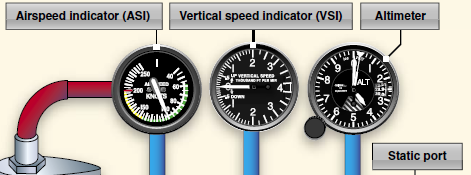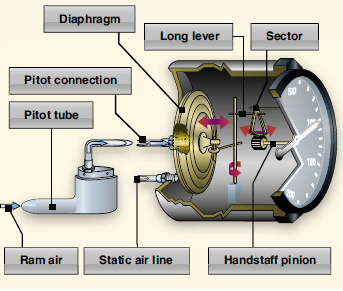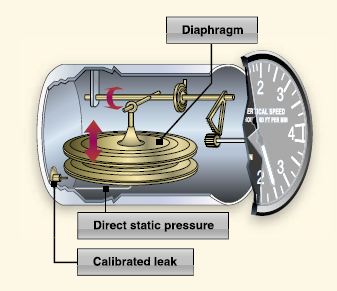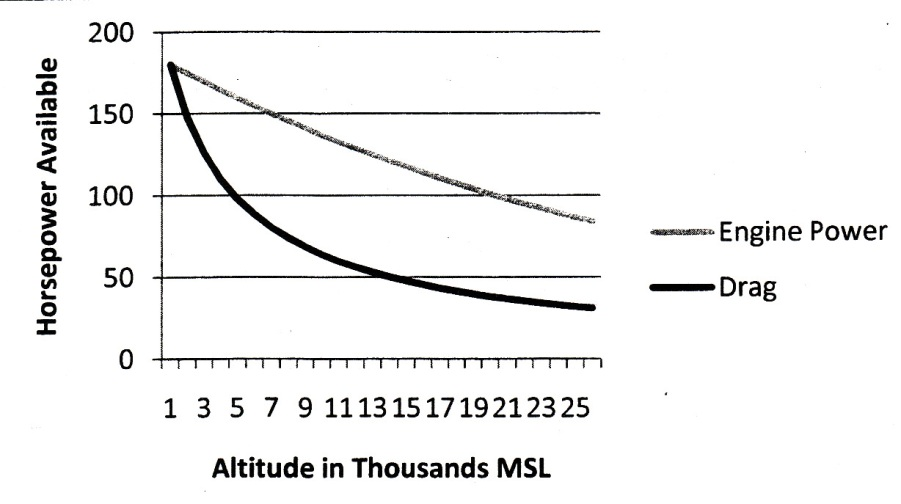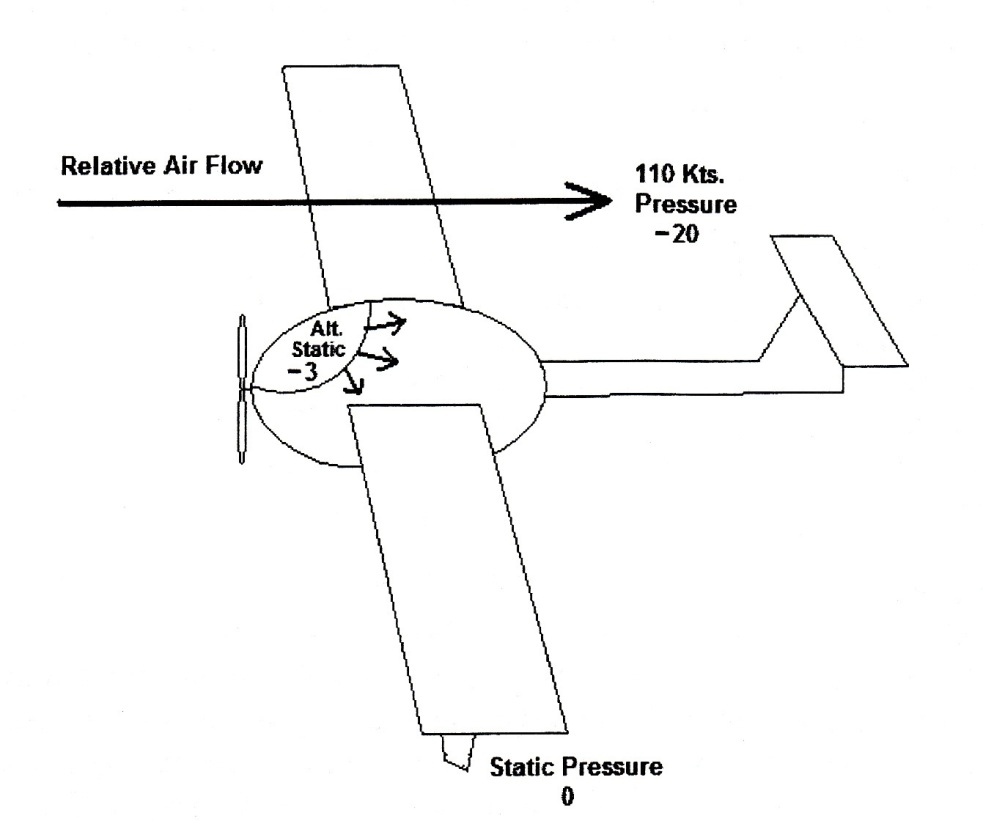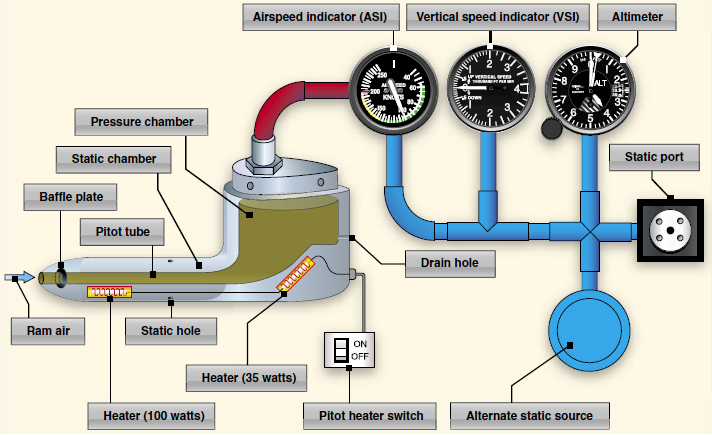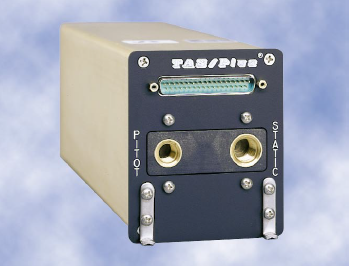Understand how a pitot static system works with aircraft instruments, their potential errors, and airspeeds relationships.
What did Daniel Bernoulli have to do with flight? Nothing
Learn to recognize pitot static instruments or they will trick you when the malfunction.
What 3 instruments are a part of the pitot static system? (draw the 3 pitot static instruments)
- Airspeed (ram and static) VSI (static +calibrated leak) Altimeter (static)
Draw pitot tube: ram air and 2 static holes—connect to all instruments
How many drain holes does the DA40 have? ZERO
Draw Alternate static source attached to the static line
AIRSPEEDS –Instruments simply measure air pressure e.g. Tire gauge.
- IAS: Airplane performance
- CAS: IAS corrected for AOA
- TAS: GS without wind. (CAS corrected for pressure & temperature)
Rule of thumb: TAS increases about 2% of the CAS per thousand feet of altitude
Why? Temperature and pressure decrease air density, therefore the aircraft must go faster to get the same amount of lift.
Drag decreases squared to the increased altitude (draw graph)
Problem: 10,000 ft altitude, 100 KIAS, GS: 110 knots. Headwind or Tailwind?
TAS=120 knots (2% x 10(thousands of feet) = 20%; 20% of 100 =20; 100 + 20 = 120)
- GS: Speed over the ground (TAS corrected for wind)
Errors: What happens if? Icing
|
Relative to same TAS |
Airspeed Indicates |
VSI Indicates |
Altimeter Indicates |
|||
|
When altitude is higher/lower than altitude when frozen |
Higher |
Lower |
Higher |
Lower |
Higher |
Lower |
|
Ram Air blocked |
Faster |
Slower |
Same |
Same |
Same |
Same |
|
Static port blocked |
Slower |
Faster |
Same |
Same |
Same |
Same |
|
Ram & Static blocked |
Same |
Same |
Same |
Same |
Same |
Same |
|
Alt Air Open |
Faster |
Faster |
Same |
Same |
Higher |
Higher |
Alternate Static source
Open=All Instrument Indications Increase
Draw airplane below
| Pressure corrected for altitude | Ambient Air 0 knots |
Ambient Air 110 knots |
Source Measured air |
| Pitot Mast | 29”Hg | 29”Hg around pitot mast |
29”Hg =static |
| Alternate Static | 29”Hg | -20”Hg around cockpit |
-3”Hg =less than static |
Bernoulli’s principle: increase in the speed of the fluid creates decrease in pressure
Daniel Bernoulli
- Cockpit pressure changes with open windows or vents.
Conclusion and Evaluation: Understanding how the instruments work and how physical attributes are measured can help us interpret data correctly and fly safer.
Resources
Definitions:
Atmospheric pressure: the weight of the air molecules; usually measured in inches of mercury(“Hg) by a barometer
Standard Level Sea Pressure: 29.92 “Hg (also in millibars at 1,013.2 mb)
Altimeter: An aneroid barometer adjustable to the local atmospheric pressure setting (corrected for altitude of reporting station) to indicate altitude in feet: we adjust our altimeter because we fly through air with different pressures
Pitot Static System: The system in the airplane that allows the altimeter to get a correct air pressure reading.
Pressure Altitude: altitude corrected for non-standard pressure—shown on altimeter when set to a sea level pressure of 29.92”
Density Altitude: Pressure altitude corrected for non-standard temperature
Atmospheric Stability: The atmosphere’s ability to resist vertical motion
Standard Lapse Rate: the rate at which temperature decreases with an increase in altitude. The average lapse rate of dry air is about 3°C/1,000feet, but because moisture is generally in the air, the average is closer to 2°C/1,000feet.
Altimeter setting: atmospheric pressure corrected for altitude
VSI: vertical speed indicator
Airspeeds
IAS: Indicated Airspeed is what is shown on your airspeed indicator. Indicated Airspeed: airplane performance speed (ram air corrected for altitude)
CAS: Calibrated Airspeed: Indicated Airspeed corrected for angle of attack (pitot installation error) (less air requires a higher angle of attack to maintain level flight)
TAS: True Airspeed: the actual speed the aircraft is moving through the air (CAS corrected for non-standard temperature & pressure)
GS: Ground Speed: Speed over the ground
Atmospheric pressure:
PHAK 11-3 Unequal heating of the Earth’s surface creates circulations patterns, causes changes in air density, and causes changes in air pressure or the force exerted by the weight of air molecules.
The actual pressure at a given place and time differs with altitude, temperature, and density of the air.
All local barometric pressure reading are converted to a sea level pressure to provide a standard for records and reports. To achieve this, each station converts its barometric pressure by adding approximately 1:Hg for every 1,000 feet of elevation. For example, a station at 5,000 feet above sea level, with a reading of 24.92”Hg, reports a sea level pressure reading of 29.92 “Hg. Using common sea level pressure readings helps ensure aircraft altimeters are set correctly, based on the current pressure readings.
Relationships:
1” mercury = 1,000 feet
PHAK 7-2
PHAK 7-14
PHAK 10-3
